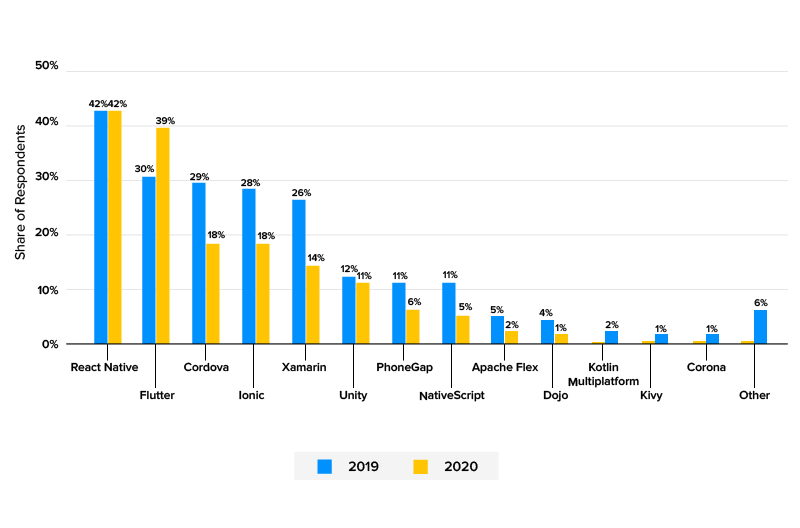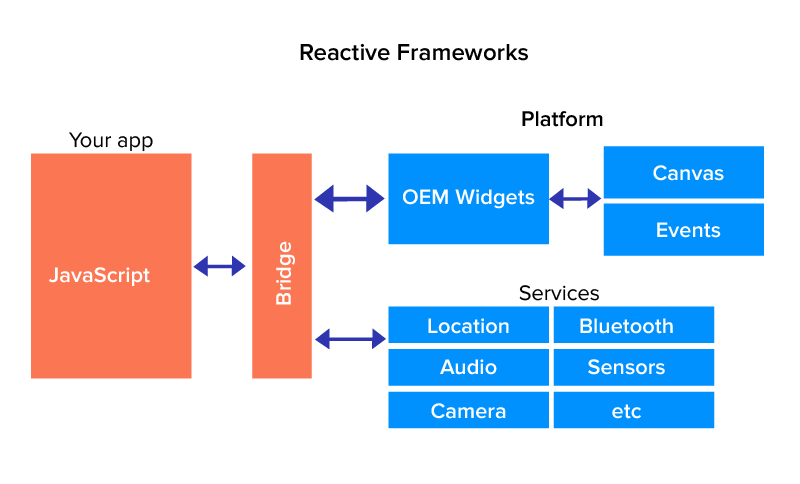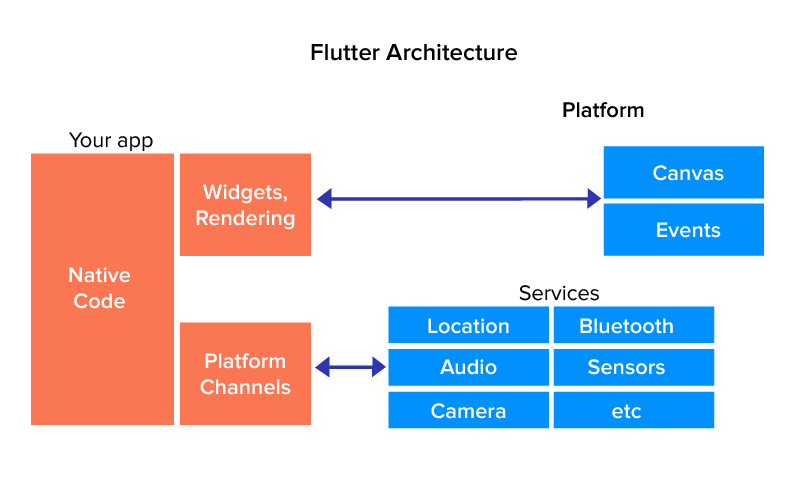Why I Believe Flutter Is the Future of Cross-platform App Development
The pace at which Flutter is growing on both market presence and features front will make it the future of cross-platform app development.
Only a few years have gone by since Google launched Flutter, but the innovation speed at which the platform is being updated has already brought it several steps ahead of some of the top cross-platform frameworks operative in the mobile app development domain.
This cross-platform framework, which was initially developed by Google for assisting ambient computing, is now being used by a number of top tech companies like Groupon, eBay, Tencent, etc. In addition to the established businesses, there are a number of startups as well that are launching their digital product through Flutter. Now Flutter is used for enterprise apps as well.
Developers are confident that the future of app development belongs to Flutter with the pace it is setting the trend in mobile development. I second their opinion.

At Appinventiv we have run n-number of hypothesis testing and built 50+ solutions on the framework to state that Flutter mobile app development services truly makes your solution future-proof.
In this article, I will be sharing a few reasons why I believe that there is a dedicated space for flutter cross platform app development in future.
Reasons That Place Flutter App Development In The Future of Cross-Platform Development

1. Single codebase for every platform
Flutter is a single codebase development framework. The application that you make on Flutter can be published on Android, iOS, desktop, and web. For a business looking to enter the digital space in minimal effort and time, Flutter cross platform app development can be a great starting point.
2. Completely customizable widgets
One of the best thing about Flutter is the fact that it supports platform centric widgets. The two set of Flutter widgets – Cupertino and Material Design – enable Flutter mobile app development companies to design platform specific UI/UX, giving users an experience which is closest to native. A sign of how updated and active the framework is in the widget department can be seen in the recent 1.22 version launch, where it extended support to iOS 14 and Android 11.
3. Faster application development
The next best thing about the framework is its capability to expedite the development and testing process. The fact that it is a single codebase framework added to the hot reload facility makes it easy for developers to build an app while testing it in real-time. This, in turn, plays a crucial role in lowering the mobile app development cost as well.
4. Wide number of open source package
Flutter comes packed with a number of free open source packages which support fast development. Some of those are: Youtube_player, Flutter Ecommerce, and Frideos_flutter. Additionally, since it is an end-to-end open source platform, developers from across the globe constantly keep adding their work to the library, making the framework more extensive.
5. Comes with great learning sources
Flutter website offers extensive resources to developers coming from a number of platforms and who are new to its declarative UI style. The efforts that the Flutter team puts behind documentation makes it one of the biggest answers of ‘Why flutter for app development?’.
The wide range of documentation when combined with the massive community that backs Flutter, the learnability curve comes down automatically.
6. Provides a great developer experience
Flutter framework comes with best-in-class IDE support through plugins for IntelliJ/Android Studio and Visual Studio Code. Moreover, Flutter mobile application development process asks developers to have knowledge of only Dart language, instead of demanding them to be experts of Swift, JavaScript and other programming languages.
The best thing about Dart is that it comes with two compilation modes – ahead-of-time and just-in-time – allowing hot reload during the app development process. Moreover, the language is statically typed, meaning it lets tools do all the heavy lifting for a Flutter app development company.
7. Low development cost
When developing a mobile application, the cost of development can’t be ignored. Startups and small businesses generally don’t have large amounts of funds to invest in app development. Moreover, apart from app development costs, you also need to consider other expenses such as team building, server cost, marketing, and more.
Flutter can help to reduce development costs. Thanks to the single-code base, you don’t need platform-specific developers. Also, the testing requirements are low, so you can get cross platform application development even if you have a low budget.
8. Best suited for MVP
App development using Flutter can help display your MVP to the investors. There is no need to develop two applications for Android and iOS. This will save you both time and resources. Also, Flutter’s compatibility with Firebase doesn’t need you to separate backends for building simple MVP. Hence, it won’t be wrong to say that Flutter is ideal for the MVP development process.
While the reasons truly make the future of Flutter promising, does it mean that the title I am giving it – The future of cross-platform app development – is justified? Well, we can only answer that when we do a comparative study of the framework with other top development platforms.
Flutter vs Other Cross-Platform Development Frameworks

Flutter vs React Native
React Native makes use of a complex and dynamic language – JavaScript – to develop cross-platform applications. The language calls for training for delivering feature-rich apps. Flutter, on the other hand, uses Dart language which is extremely easy to learn and use.
Secondly, unlike React Native, Flutter developers don’t have to separate data or template when using Flutter and they can code everything through a central location. React Native developers on the other side depend on third-party libraries to develop their apps.
The third difference lies in the Architecture.
Here’s what the React native and Flutter architecture looks like –

Flutter architecture –

React Native consists of two parts in the architecture – Native components and the JS language. An application developed using React Native is built on JavaScript but uses a bridge to interact with native components like camera, GPS, audio etc. Flutter, on the other hand, doesn’t need a bridge to connect the application with the native components. The end result? The app running speed is much faster in Flutter compared to React Native.
Flutter vs. Xamarin
Both Flutter and Xamarin are open-source but Xamarin takes payment for commercial development while Flutter is end-to-end free. Moreover, Xamarin uses forms, which declines the app performance due to the additional abstraction layer.
Lastly, the Xamarin app faces slight glitches when you introduce heavy graphics. Flutter, however, supports applications with complex visuals – making them a great choice for gaming-based applications.
Flutter vs. Ionic
There are a number of similarities between Ionic and Flutter. Both the platforms support development of high-performance applications with native like experience.
But while Ionic is a great choice for web or desktop applications (for now) developers prefer using Flutter development services for mobile platforms. Reason is because Ionic makes use of web technologies which tend to lower the speed and the app performance, while Flutter comes with app-centric libraries and widgets that make it a great fit for mobile-based applications.
Right from the reasons why I think Flutter mobile development is the future, to the comparisons between the framework and other development platforms, we have been looking into the ways features of Flutter makes it ideal for cross-platform application development today and in the future.
But does it mean that businesses must ditch native development for flutter app development services? Well, the answer is no.
While the framework is well on the path to become THE solution for entrepreneurs looking to launch their solution on multiple platforms simultaneously with half the developmental efforts and time, the answer to is Flutter the future of mobile development is ‘No’.
Flutter, like every other cross-platform development platform lack the quality that a native application offers. Right from the native access to device in-built features like camera, microphone, map, etc to the ability to support highly concurrent applications – there are things that Flutter lacks. So, while I suggest entrepreneurs looking for a fast, low cost solution for their ideas falling in the ‘simple’ category or if they are looking for MVP development to go for Flutter, the framework is not an answer to complex digital solutions.
Even though the framework is years away from being Native’s replacement, there are a number of ways Flutter will continue to get better in 2021.
How Will Flutter for Mobile Development Continue to Get better in 2021
A Flutter app development company has a lot to look ahead for this year:
- Dart’s null safety will be introduced – Migration of the package ecosystem and plugin will be shepherded to null safety in Flutter.
- The ergonomics and performance of embedding Flutter in the existing iOS and Android application will be improved
- Production-quality support will be given for macOS, Web, Linux, and Windows
- Overall Flutter app quality will be improved through dedicated efforts on runtime performance, application download size overhead, memory usage, battery usage, etc.
Here are the many reasons why I believe that the speed at which Flutter is expanding, the future of mobile app development will see the framework ruling the sector. If you too are looking to build your digital solution on a future-proof platform, hire flutter app developers, today. We are a leading flutter app development company in USA.

strategies your digital product..




